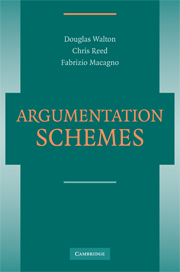Book contents
- Frontmatter
- Contents
- Acknowledgments
- Introduction
- 1 Basic Tools in the State of the Art
- 2 Schemes for Argument from Analogy, Classification, and Precedent
- 3 Knowledge-Related, Practical, and Other Schemes
- 4 Arguments from Generally Accepted Opinions, Commitment, and Character
- 5 Causal Argumentation Schemes
- 6 Schemes and Enthymemes
- 7 Attack, Rebuttal, and Refutation
- 8 The History of Schemes
- 9 A User's Compendium of Schemes
- 10 Refining the Classification of Schemes
- 11 Formalizing Schemes
- 12 Schemes in Computer Systems
- Bibliography
- Index
7 - Attack, Rebuttal, and Refutation
Published online by Cambridge University Press: 05 June 2012
- Frontmatter
- Contents
- Acknowledgments
- Introduction
- 1 Basic Tools in the State of the Art
- 2 Schemes for Argument from Analogy, Classification, and Precedent
- 3 Knowledge-Related, Practical, and Other Schemes
- 4 Arguments from Generally Accepted Opinions, Commitment, and Character
- 5 Causal Argumentation Schemes
- 6 Schemes and Enthymemes
- 7 Attack, Rebuttal, and Refutation
- 8 The History of Schemes
- 9 A User's Compendium of Schemes
- 10 Refining the Classification of Schemes
- 11 Formalizing Schemes
- 12 Schemes in Computer Systems
- Bibliography
- Index
Summary
In this chapter we develop a pragmatic theory of refutation in which a refutation is defined as a sequence of dialogue moves in which an argument is used by one party to attack and defeat an opposed argument put forward previously by the other party. A fundamental distinction is drawn between refutation and rebuttal. A rebuttal is an argument that is opposed to another argument. It stands against the argument it is opposed to. But it does not necessarily refute that argument. Refutation is something more powerful. A refutation knocks down the original argument. It not only is opposed to the original argument, but also has enough strength itself as an argument that it overpowers the original argument and knocks it down (defeats it). This distinction is not a very firm or precise one in everyday conversational usage. An attempted refutation is, after all, a refutation in conversational English, even if it is not strong enough to knock down the argument it is opposed to. But still, as we hope to show, there is something to this distinction. Refutation is stronger than rebuttal. A refutation is something like a strong rebuttal, or a rebuttal that has active force in successfully attacking the argument it is aimed at.
A parallel distinction that has been very influential in recent work in artificial intelligence can be drawn between attacking and defeating an argument (Dung, 1995; Prakken, 1997).
Information
- Type
- Chapter
- Information
- Argumentation Schemes , pp. 220 - 274Publisher: Cambridge University PressPrint publication year: 2008
Accessibility standard: Unknown
Why this information is here
This section outlines the accessibility features of this content - including support for screen readers, full keyboard navigation and high-contrast display options. This may not be relevant for you.Accessibility Information
- 1
- Cited by
